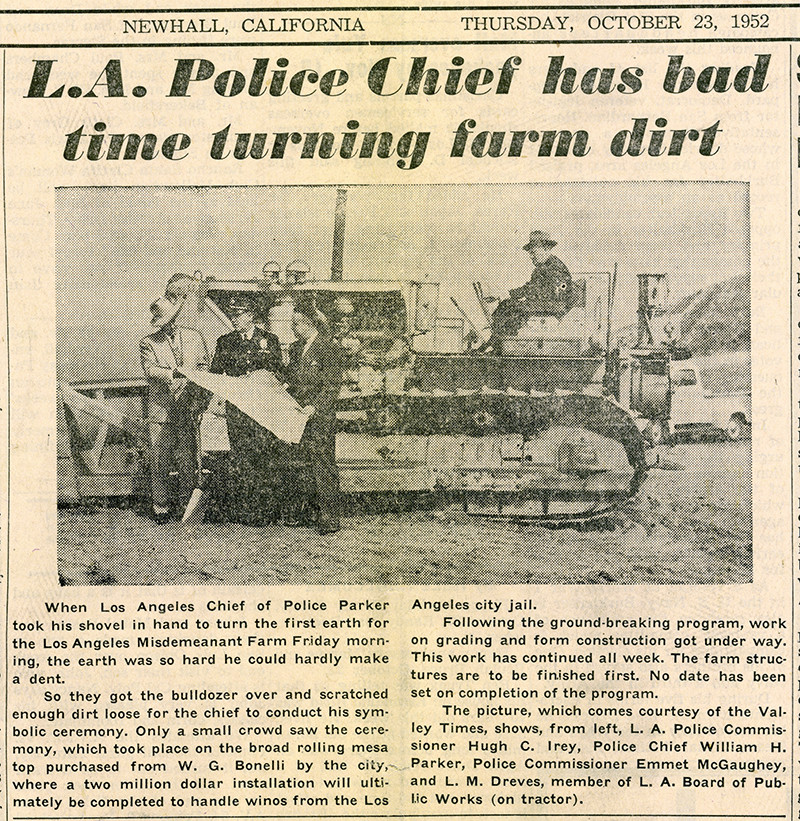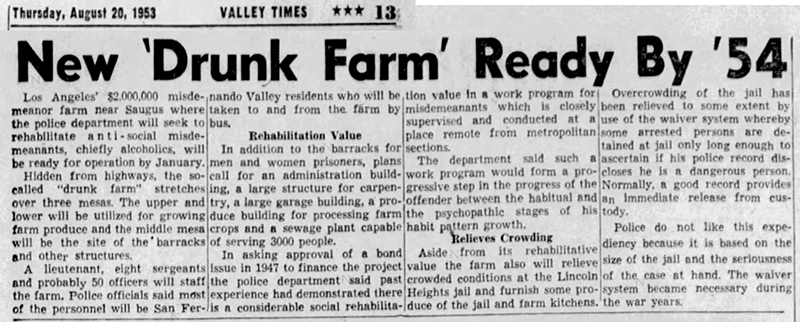Webmaster's note.
The hilltop became the site of the Castaic Lake Water Agency's Rio Vista Water Treatment Plant (opened 1995), and some of the acreage that was farmed became Santa Clarita Central Park (opened 2000).

Click to enlarge.
|
Break ground for new L.A. police jail farm Friday.
The Newhall Signal | Thursday, October 16, 1952, pg 1.
Ground will be broken at 10 a.m. this Friday for a $2,000,000 Los Angeles Police Department Rehabilitation Center for alcoholic prisoners at 27000 Bouquet Canyon Road, near Saugus, Police Chief Parker announced Tuesday.
When completed by about next October, the center will consist of 25 barracks-type dormitories of concrete block construction, two kitchens and mess halls, a two-story administration building and quarters for police personnel and a receiving hospital doctor.
Eventual capacity will be 1,500 prisoners, but present plans call for initial construction of only 10 of the dormitories to house 600 prisoners.
On Bonelli Site
The center will be built on a 581-acre site purchased by the city from the William G. Bonelli Ranch for $209,000. Construction contract has been awarded to the Ford J. Twaits Company on its low bid of $1,723,835.
Farming of tillable land by the prisoners will make the center self-supporting, it was pointed out. Sharecropping of 140 acres of the property on a 50-50 basis already has produced $2,000 in revenue for the city.
The center will be manned 24 hours a day by a total of 70 police officers, eight sergeants and a lieutenant in charge. Captain Gilbert Gilmore, head of the welfare and rehabilitation division, will be in command.
Chief Parker said it is hoped that the center will make possible rehabilitation of many of the alcoholics who are arrested repeatedly at a cost to the city of about $1,000,000 a year.
— Los Angeles Times.

Click to enlarge.
|
L.A. Police Chief has bad time turning farm dirt.
The Newhall Signal | Thursday, October 23, 1952, pg 1.
When Los Angeles Chief of Police Parker took his shovel in hand to turn the first earth for the Los Angeles Misdemeanant Farm Friday morning, the earth was so hard he could hardly make a dent.
So they got the bulldozer over and scratched enough dirt loose for the chief to conduct his symbolic ceremony. Only a small crowd saw the ceremony, which took place on the broad rolling mesa top purchased from W.G. Bonelli by the city, where a two million dollar installation will ultimately be completed to handle winos from the Los Angeles city jail.
Following the ground breaking program, work on grading and form construction got under way. This work has continued all week. The farm structures are to be finished first. No date has been set on completion of the program.
The picture, which comes courtesy of the Valley Times, shows, from left, L.A. Police Commissioner Hugh C. Irey, Police Chief William H. Parker, Police Commissioner Emmet McGaughey, and L.M. Dreves, member of L.A. Board of Public Works (on tractor).

Click image to enlarge.
New 'Drunk Farm' Ready by '54.
Valley Times | Thursday, August 20, 1953.
Los Angeles' $2 000,000 misdemeanor farm near Saugus where the police department will seek to rehabilitate anti-social misdemeanants, chiefly alcoholics, will be ready for operation in January.
Hidden from highways, the co-called "drunk farm" stretches over three mesas. The upper and lower will be utilized for growing farm produce, and the middle mesa will be the site of the barracks and other structures.
A lieutenant, eight sergeants and probably 50 officers will staff the farm. Police officials said most of the personnel will be San Fernando Valley residents who will be taken to and from the farm by bus.
In addition to the barracks for men and women prisoners, plans call for an administration building, a large structure for carpentry, a large garage building, a produce building for processing farm crops and a sewage plant capable of serving 3,000 people.
In asking approval of a bond issue in 1947 to finance the project, the police department said past experience had demonstrated there is a considerable social rehabilitation value in a work program for misdemeanants, which is closely supervised and conducted at a place remote from metropolitan sections.
The department said such a work program would form a progressive step in the progress of the offender between the habitual and the psychopathic stages of his habit pattern growth.
Aside from its rehabilitative value, the farm will also relieve crowded conditions at the Lincoln Heights Jail and furnish some produce of the jail and farm kitchens.
Overcrowding of the jail has been relieved to some extent by use of the waiver system whereby some arrested persons are detained at jail only long enough to ascertain if his police record discloses he is a dangerous person. Normally, a good record provides an immediate release from custody.
Police do not like this expediency because it is based on the size of the jail and the seriousness of the case at hand. The waiver system became necessary during the war years.









